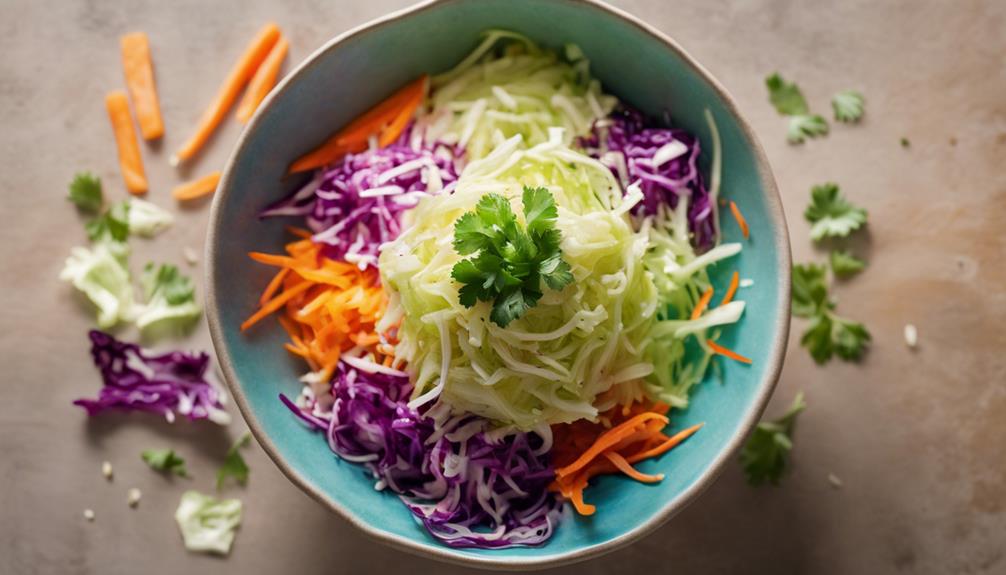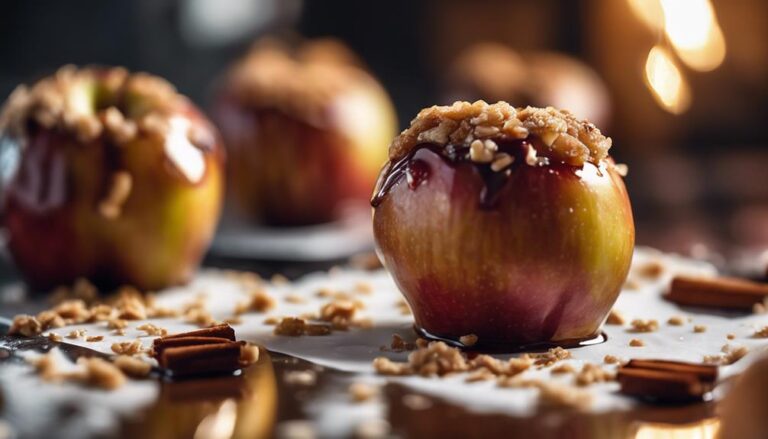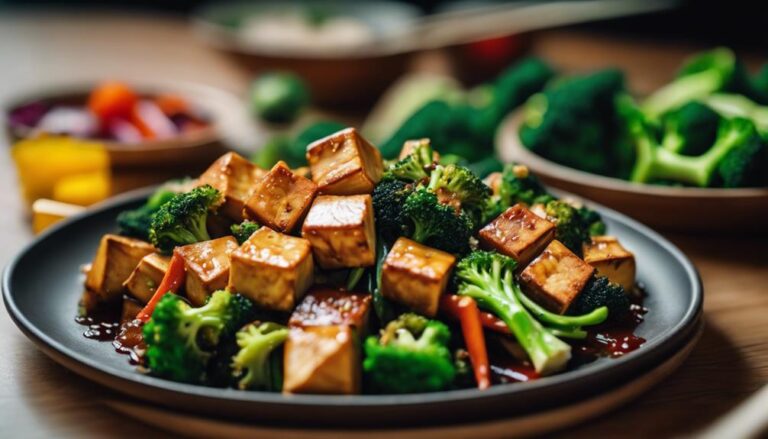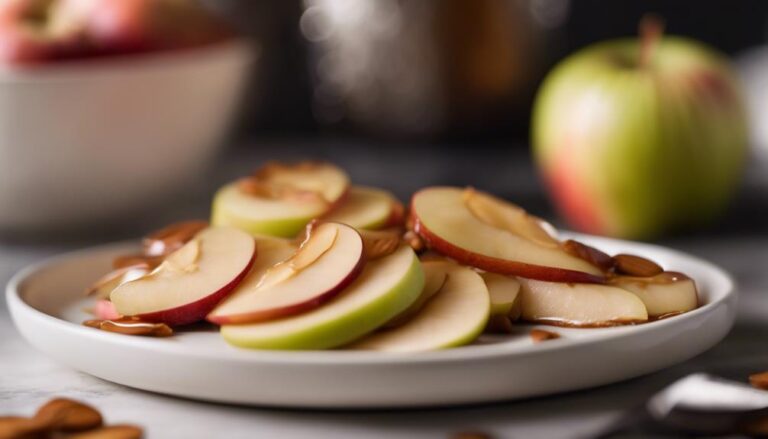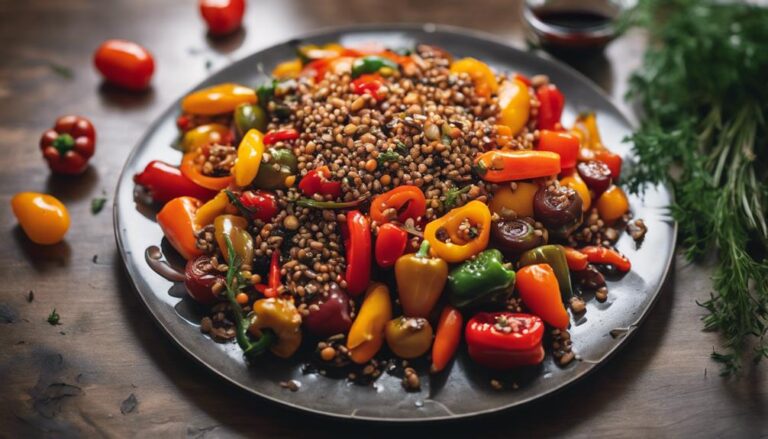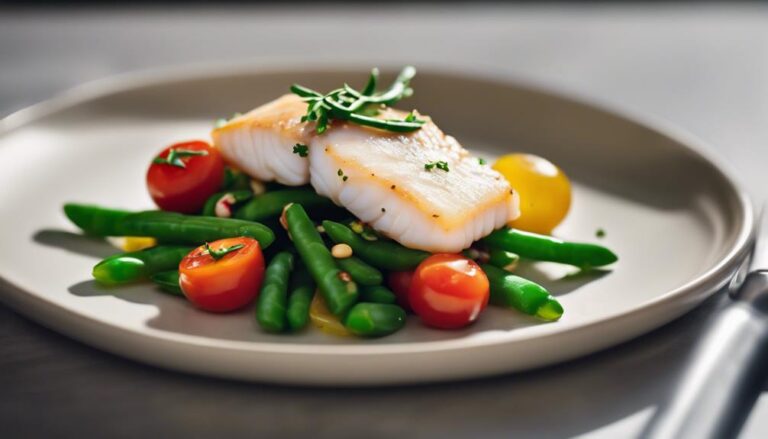Sous Vide Asian Style Cabbage Slaw
In Asian cuisine, cabbage plays a crucial role, with its versatility in various dishes. When crafting a Sous Vide Asian Style Cabbage Slaw, key components like soy sauce, rice vinegar, and sesame oil provide flavorful depth. Explore unique varieties like Sesame Ginger Cabbage Slaw for an unexpected twist. Efficiently shred cabbage using a mandoline slicer for uniformity. Balance flavors with a blend of soy sauce, rice vinegar, sesame oil, ginger, and garlic. Achieve a satisfying crunch by incorporating finely shredded and thicker slices. Elevate your slaw with sweet, tangy, and savory notes, ideal for pairing with grilled meats or tacos. For more tips and insights, explore further into Asian cabbage slaw creations.
What You Will Learn Here
- Sous vide method for precise temperature control
- Infuse Asian flavors during sous vide process
- Retain cabbage's crunch and freshness
- Enhance flavors with soy sauce, ginger, and garlic
- Experiment with different seasonings for unique slaw
Cabbage's Asian Culinary Roots
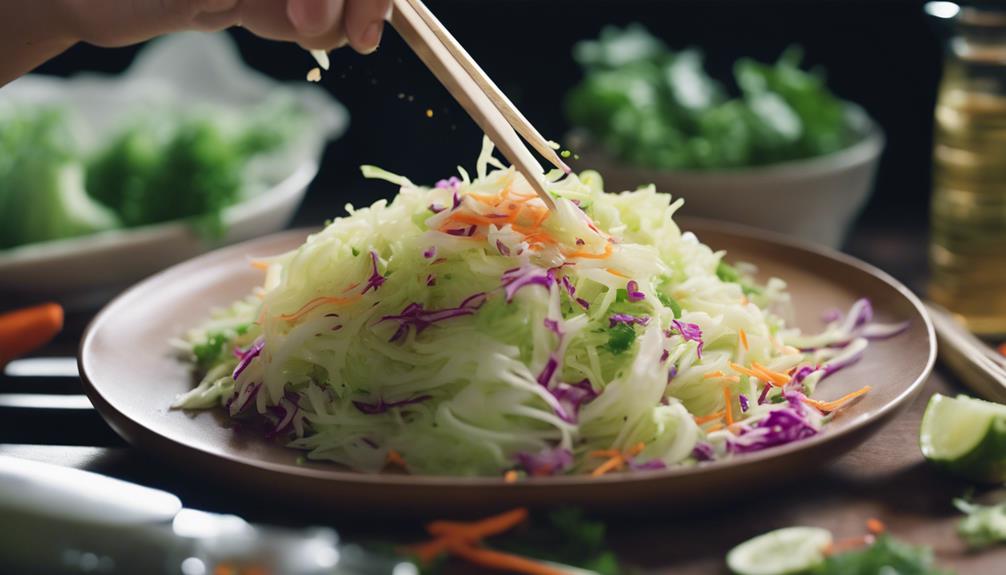
Asian cuisine has a long history of incorporating cabbage in various dishes. Cabbage holds significant culinary importance in Asian cooking, featuring prominently in traditional recipes across the continent.
From kimchi in Korea to stir-fried cabbage dishes in China, the versatile vegetable plays a central role in Asian culinary traditions.
Asian Cabbage Origins
Have you ever wondered where cabbage's culinary journey in Asia began? Asian agriculture has played an important role in the cultivation of cabbage, with its origins dating back thousands of years. Cabbage is believed to have been domesticated in the region that includes parts of modern-day Turkey and Myanmar. From there, it spread across Asia, adapting to various climates and soils.
In Asian agricultural practices, cabbage cultivation became widespread due to its adaptability and nutritional value. Farmers in regions like China, Korea, and Japan began cultivating different varieties of cabbage, each suited to the local growing conditions. The versatility of cabbage made it a staple in Asian cuisine, featuring in a wide range of dishes from stir-fries to pickled preparations.
As cabbage continued to be cultivated and integrated into Asian culinary traditions, it became a symbol of prosperity and good luck in some cultures. The humble cabbage's journey from its early cultivation to becoming a beloved ingredient in Asian cuisine showcases the rich history and agricultural significance of this versatile vegetable.
Culinary Significance in Asia
Cabbage's journey from being a staple in Asian cuisine to symbolizing prosperity and good luck showcases its deep-rooted culinary significance in the region. Throughout Asia, cabbage holds a prominent place in culinary traditions, thanks to its versatility and adaptability to various cooking techniques. In countries like China, Japan, and Korea, cabbage isn't just a vegetable but a symbol of abundance and wealth. Its crisp texture and mild flavor make it a favorite ingredient in stir-fries, soups, and pickled dishes.
Asian culinary techniques often involve fermenting or pickling cabbage to enhance its flavor and preserve it for longer periods. Kimchi, a famous Korean side dish made from fermented cabbage, exemplifies the cultural influences on cabbage preparation. The balance of sweet, sour, and spicy flavors in dishes like Chinese cabbage salad highlights the culinary diversity across Asia.
Whether steamed, stir-fried, or pickled, cabbage continues to play a crucial role in Asian cuisine, reflecting the region's rich culinary heritage.
Traditional Cabbage Recipes
Exploring traditional cabbage recipes reveals a tapestry of flavors and techniques deeply embedded in Asian culinary roots. Cabbage has long been a staple in Asian cuisine, with recipes that showcase the region's diverse culinary traditions. In Asian fusion dishes, cabbage is often paired with bold flavors like soy sauce, ginger, and garlic to create a harmonious blend of tastes.
One of the most prominent methods of preparing cabbage in Asian cuisine is through the fermentation process. This technique not only enhances the cabbage's flavor but also promotes the growth of beneficial probiotics that are excellent for gut health. Kimchi, a popular Korean dish made of fermented cabbage, exemplifies the depth of flavor that can be achieved through this process.
In traditional cabbage recipes, the fermentation process is revered for its ability to transform the humble cabbage into a complex and tangy dish that pairs well with rice, noodles, or meats. By understanding the rich history of cabbage in Asian culinary traditions, you can appreciate the depth of flavors that this versatile vegetable brings to the table.
Cabbage Slaw Dressing Components
For a tangy and flavorful dressing for your Asian Style Cabbage Slaw, combine soy sauce, rice vinegar, sesame oil, and a touch of honey. These components come together to create a harmonious blend of savory, sweet, and tangy flavors that will elevate your slaw to new heights.
- Soy Sauce: Adds a rich umami flavor that complements the freshness of the cabbage.
- Rice Vinegar: Provides a gentle acidity that brightens up the dish and enhances the other flavors.
- Sesame Oil: Infuses a nutty aroma and depth of flavor that ties everything together beautifully.
When exploring dressing variations with Asian influences, consider experimenting with ingredients like miso paste, ginger, or even a splash of mirin for a unique twist. For flavorful pairings and cabbage mix-ins, think about adding toasted sesame seeds, chopped scallions, or a sprinkle of red pepper flakes to introduce different textures and layers of taste to your slaw.
Savory Cabbage Slaw Varieties
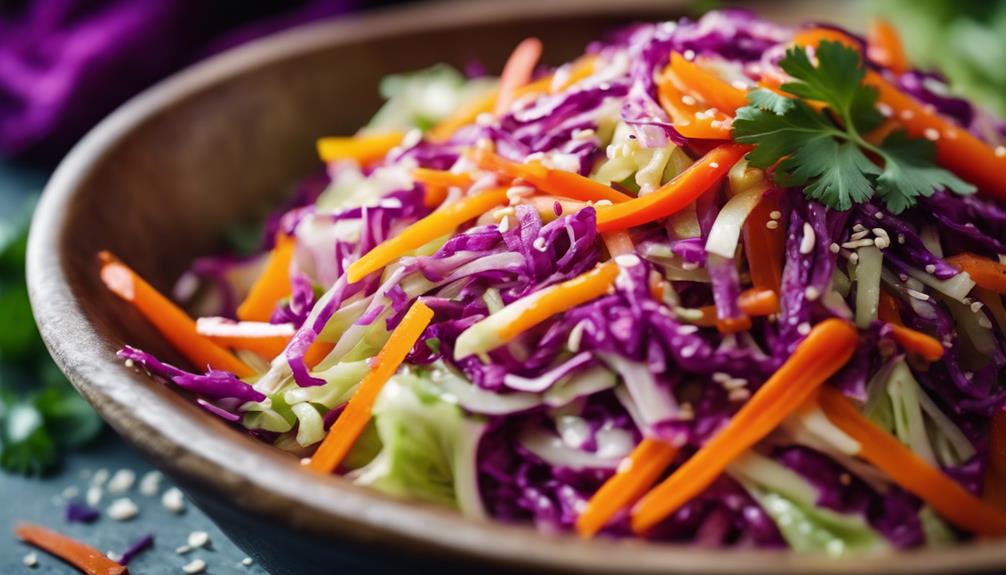
When it comes to savory cabbage slaw varieties, you have some exciting options to explore.
Try the Sesame Ginger Cabbage Slaw for a flavorful twist, or go for the Tangy Asian Cabbage Slaw for a zesty kick.
For a unique take, consider the Unique Cabbage Slaw Twist to add a creative spin to your meal.
Sesame Ginger Cabbage Slaw
To enhance the flavor of your cabbage slaw, consider incorporating a delicious sesame ginger dressing. This flavorful dressing will elevate your slaw to new heights of taste and satisfaction. Here are three reasons why you should try this sesame ginger cabbage slaw:
- Complex Flavor Profile: The combination of nutty sesame and zesty ginger creates a harmonious blend of flavors that will tantalize your taste buds.
- Asian Fusion Delight: Experience the fusion of traditional Asian ingredients in a modern dish that will transport you to culinary paradise.
- Versatile Pairing: This sesame ginger dressing complements a variety of proteins and can be enjoyed as a standalone dish or as a side to your favorite main course.
Tangy Asian Cabbage Slaw
Consider adding a tangy twist to your cabbage slaw with vibrant Asian flavors that will awaken your taste buds.
To create a tangy Asian cabbage slaw, try incorporating spicy cabbage for a kick of heat that complements the crunchy texture of the slaw. Additionally, adding pickled cabbage can bring a tangy and slightly sour element to the dish, enhancing the overall flavor profile.
The combination of these ingredients will elevate your cabbage slaw to a whole new level, perfect for summer barbecues or as an invigorating side dish for any meal. Experimenting with different variations of cabbage and seasonings allows you to customize the slaw to your taste preferences, making it a versatile and flavorful addition to your culinary repertoire.
Unique Cabbage Slaw Twist
For a distinctive twist on cabbage slaw, explore savory varieties that promise to tantalize your taste buds with unexpected flavors and textures.
- Flavorful fermentation: Experiment with fermenting your cabbage slaw to introduce a tangy and complex taste profile that develops over time, adding depth and richness to your dish.
- Colorful presentation: Incorporate a variety of colorful ingredients like purple cabbage, vibrant bell peppers, and bright carrots to not only enhance the visual appeal of your slaw but also provide a spectrum of nutrients.
- Unexpected textures: Add crunchy elements such as toasted nuts, crispy fried shallots, or even pomegranate seeds to your cabbage slaw for a delightful textural contrast that keeps your palate engaged with every bite.
Embracing these savory cabbage slaw varieties can elevate your culinary experience, offering a delightful departure from traditional recipes and introducing a world of new flavors and sensations to savor.
Crisp Cabbage Slaw Techniques
To achieve a crisp cabbage slaw, start by shredding the cabbage efficiently to guarantee uniformity in texture.
Seasoning is essential for vibrant flavors; consider using a mix of spices and herbs to enhance the taste profile.
Lastly, aim to balance textures in the slaw by incorporating crunchy elements like nuts or seeds alongside the cabbage for a satisfying bite.
Shredding Cabbage Efficiently
For achieving the crispest cabbage slaw, begin by mastering the effective technique of shredding cabbage. When it comes to efficient chopping, start by removing the outer leaves of the cabbage and cutting it in half. Place the flat side down on the cutting board to provide stability. Using a sharp knife, slice the cabbage thinly by making long, smooth cuts. For quick preparation, consider using a mandoline slicer to speed up the process even further. This tool guarantees uniform cuts and saves time in the kitchen.
Effectively shredded cabbage is essential for a well-balanced slaw. The thin slices allow the flavors of the dressing to coat each piece evenly, enhancing the overall taste of the dish. By taking the time to shred the cabbage properly, you'll create a more enjoyable eating experience for you and your guests. So, next time you're preparing a cabbage slaw, remember the significance of efficient chopping techniques for a delicious and satisfying outcome.
Seasoning for Vibrant Flavors
After efficiently shredding the cabbage for your slaw, the next step is to enhance its flavor with vibrant seasonings. Adding flavorful seasonings is key to achieving a delicious taste infusion in your Asian style cabbage slaw. Consider using a combination of ingredients like soy sauce, rice vinegar, sesame oil, ginger, and garlic to create a harmonious blend of flavors that will elevate the dish.
To begin, mix soy sauce for a savory umami taste that will complement the freshness of the cabbage. Next, incorporate rice vinegar to provide a subtle tanginess that brightens the overall flavor profile. A drizzle of sesame oil adds a nutty richness, while fresh ginger and garlic bring a hint of warmth and depth to the slaw.
Balancing Textures in Slaw
Achieve a satisfying crunch in your cabbage slaw by mastering the art of balancing textures through precise shredding techniques. Texture contrast is vital in creating a dynamic slaw that keeps your taste buds intrigued with every bite. To achieve this, consider using a mix of finely shredded cabbage for a delicate texture and thicker slices for a more robust crunch. By incorporating both types of cuts, you create a harmonious blend of textures that elevate the overall eating experience.
In addition to texture, flavor balance plays an essential role in perfecting your slaw. Pairing the crispness of cabbage with the right combination of ingredients such as tangy vinegar, sweet honey, zesty lime, and savory soy sauce can create a flavor profile that complements the crunchy texture. Experiment with different seasonings and dressings to find the ideal balance that enhances the natural flavors of the cabbage while adding depth to the dish. By focusing on both texture contrast and flavor balance, you can create a cabbage slaw that isn't only visually appealing but also a delight to your taste buds.
Final Thoughts
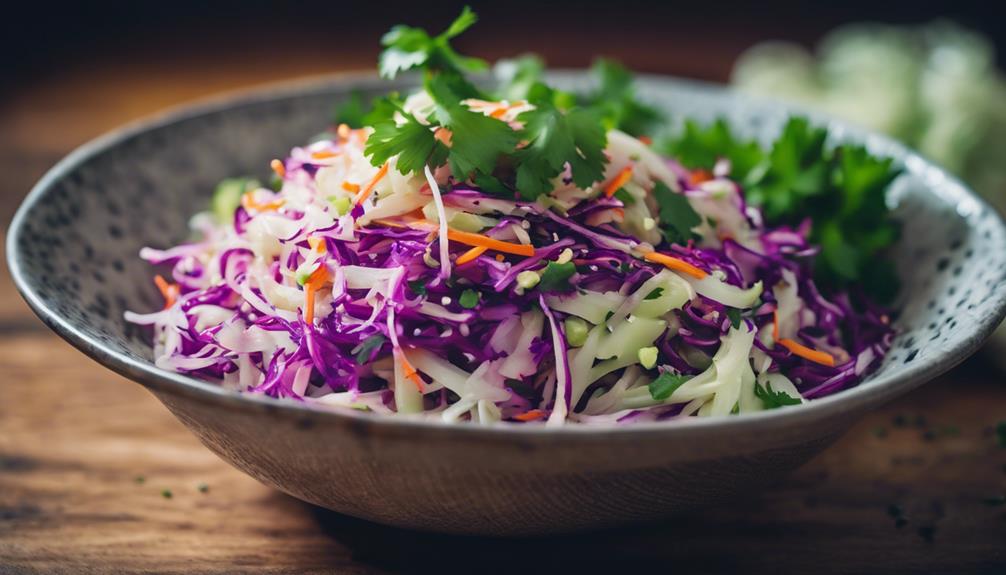
What key takeaways can you gather from this Asian Style Cabbage Slaw recipe journey? When reflecting on flavors, you'll notice the harmonious blend of sweet, tangy, and savory notes that elevate the humble cabbage into a vibrant and invigorating dish. The marriage of soy sauce, rice vinegar, and honey creates a balanced dressing that enhances the natural crunch of the cabbage, carrots, and bell peppers. The subtle heat from the ginger and garlic adds a layer of complexity without overpowering the slaw's overall taste.
For serving suggestions, consider pairing this Asian Style Cabbage Slaw as a side dish to grilled meats like teriyaki chicken or alongside crispy tofu for a vegetarian option. The slaw's versatility also shines when used as a topping for tacos or as a filling for fresh spring rolls. Its bright colors and bold flavors make it a delightful addition to any summer barbecue or potluck gathering. Whether enjoyed on its own or as part of a larger meal, this slaw is sure to impress with its invigorating taste and crunchy texture.
Frequently Asked Questions
Can I Substitute Regular Cabbage With Napa Cabbage in This Recipe?
Yes, you can substitute regular cabbage with napa cabbage in the recipe. Napa cabbage has a milder flavor profile that works well in Asian dishes. The texture may vary slightly, but it will still complement the flavors nicely.
Is It Possible to Make This Slaw Spicy by Adding Chili Peppers?
You can definitely add spicy flavor to the slaw by incorporating chili peppers. They're a staple in Asian cuisine for heat, so feel free to adjust the heat level to suit your taste preferences. Enjoy the kick!
How Long Can the Sous Vide Cabbage Slaw Be Stored in the Fridge?
To maximize freshness and shelf life, store the sous vide cabbage slaw in an airtight container in the fridge. Proper storage options guarantee your meal prep stays tasty for up to 3-5 days, allowing you to enjoy it longer.
Can I Use a Different Type of Vinegar Instead of Rice Vinegar?
Yes, you can use a different vinegar for a unique taste. Flavorful substitutions like apple cider or white wine vinegar work well in place of rice vinegar. Experiment to find your favorite flavor profile.
Are There Any Alternative Ingredients to Fish Sauce for a Vegetarian Version?
For a vegetarian version, consider using soy sauce, tamari, or miso paste as flavorful alternatives to fish sauce. These options provide umami substitutes and enhance the dish with their rich flavors, offering unique ethnic twists.
Conclusion
To sum up, sous vide Asian style cabbage slaw offers a delicious and unique twist on a classic dish. By infusing the cabbage with savory flavors and maintaining its crisp texture, this recipe brings out the best of Asian culinary traditions.
Experiment with different dressings and techniques to customize your slaw to your taste preferences. Whether as a side dish or a main course, this cabbage slaw is sure to impress your taste buds. Enjoy!
